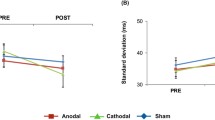Summary
Negative cortical DC shifts preceding and accompanying the execution of four different motor tasks were analysed in 18 subjects (Ss): Repetitive flexions and extensions of the forefinger had to be performed either by the right (1) or the left (2) hand. This simple motor task was compared to a complex one in which flexions and extensions of forefinger and hand had to be alternated in a fixed sequence. The complex task had either to be performed by the right (3) or the left (4) hand. Thus, the four conditions differed in the side of the performing hand (right/left) and in task-complexity (simple/complex). After its voluntary initiation, each task had to be performed for at least a period of six seconds. A Bereitschaftspotential (BP) preceded the voluntary initiation of the movement. Task-performance was accompanied by a negative DC shift called a performance-related negativity (N-P). Amplitudes of BP and N-P were compared by analysis of variance (ANOVA) using the factors “performing hand” (right/left) and “task-complexity” (simple/complex). “Performing hand” had significant effects on N-BP and N-P in C3* and C4* (positioned over the primary motor cortex) but did not influence mid-central (Cz*), frontal (F3, Fz, and F4) or parietal (P3, Pz, P4) recordings. “Task-complexity” had significant effects on N-P in mid-central (Cz*, C1*, C2*) and parietal (P3, Pz) recordings with higher negativity for complex movements. Recordings in C3* and C4* did not vary with “task complexity”. Dissociative effects of “performing hand” and “task-complexity” indicate that movement-related DC-potential shifts in C3*/ C4* can functionally be separated from those recorded in Cz*. Variations depending on the specific properties of the tasks were found to be larger during performance than during preparation of the task.
Similar content being viewed by others
References
Arezzo J, Vaughan HG Jr (1975) Cortical potentials associated with voluntary finger movements in the monkey. Brain Res 88: 99–104
Benecke R, Dick JPR, Rothwell JC, Day BL, Marsden CD (1985) Increase of the Bereitschaftspotential in simultaneous and sequential movements. Neurosci Lett 62: 347–352
Boschert J, Deecke L (1986) Cerebral potentials preceding voluntary toe, knee and hip movements and their vectors in human precentral gyrus. Brain Res 376: 175–179
Brunia CHM, Vingerhoets AJJM (1981) Opposite hemisphere differences in movement-related potentials preceding toe plantarflexion and dorsiflexion. Hum Neurobiol 2: 87–90
Deecke L (1987) Bereitschaftspotential as an indicator of movement preparation in supplementary motor area and motor cortex. In: Porter R (ed) Motor areas of the cerebral cortex, Ciba Foundation Symposium 132. Wiley, Chichester, pp 231–250
Deecke L, Kornhuber HH (1978) An electrical sign of participation of the mesial “supplementary” motor cortex in human voluntary finger movements. Brain Res 159: 473–476
Deecke L, Grözinger B, Kornhuber HH (1976) Voluntary finger movement in man: cerebral potentials and theory. Biol Cybern 23: 99–119
Goldberg G (1986) Supplementary motor area structure and function: review and hypotheses. Behav Brain Sci 8: 567–616
Grünewald G, Grünewald-Zuberbier E, Hömberg V, Netz J (1978) Cerebral potentials during smooth goal-directed hand movements in right-handed and left-handed subjects. Pflügers Arch 381: 39–46
Kornhuber HH, Deecke L (1965) Hirnpotentialänderungen bei Willkürbewegungen und passiven Bewegungen des Menschen: Bereitschaftspotential und reafferente Potentiale. Pflügers Arch 284: 1–17
Lang W, Lang M, Podreka I, Steiner M, Uhl F, Suess E, Müller Ch, Deecke L (1988a) DC-potential shifts and regional cerebral blood flow reveal frontal cortex involvement in human visuomotor learning. Exp Brain Res 71: 353–364
Lang W, Lang M, Uhl F, Koska Ch, Kornhuber A, Deecke L (1988b) Negative cortical DC shifts preceding and accompanying simultaneous and sequential finger movements. Exp Brain Res 71: 579–587
Lee BI, Lüders H, Lesser RP, Dinner DS, Morris HH (1986) Cortical potentials related to voluntary and passive finger movements recorded from subdural electrodes in humans. Ann Neurol 20: 32–37
Oldfield RC (1971) The assessment and analysis of handedness: the Edinburgh inventory. Neuropsychologia 9: 97–113
Orgogozo JM, Larsen B (1979) Activation of the supplementary motor area during voluntary movement in man suggests its work as a supramotor area. Science 206: 847–850
Roland PE, Larsen B, Lassen NA, Skinhoj E (1980a) Supplementary motor area and other cortical areas in organization of voluntary movements in man. J Neurophysiol 43: 118–136
Roland PE, Skinhoj E, Lassen NA, Larsen B (1980b) Different cortical areas in man in organization of voluntary movements in extrapersonal spaces. J Neurophysiol 43: 137–150
Roland PE, Meyer E, Shibasaki T, Yamamoto YL, Thompson CJ (1982) Regional cerebral blood flow changes in cortex and basal ganglia during voluntary movements in normal human volunteers. J Neurophysiol 48: 467–480
Schmidt RA (1975) A schema theory of discrete motor skill learning. Psychol Rev 82: 225–260
Shibasaki H, Barrett G, Halliday E, Halliday AM (1980) Components of the movement-related cortical potential and their scalp topography. Electroencephalogr Clin Neurophysiol 49: 213–226
Author information
Authors and Affiliations
Rights and permissions
About this article
Cite this article
Lang, W., Zilch, O., Koska, C. et al. Negative cortical DC shifts preceding and accompanying simple and complex sequential movements. Exp Brain Res 74, 99–104 (1989). https://doi.org/10.1007/BF00248283
Received:
Accepted:
Issue Date:
DOI: https://doi.org/10.1007/BF00248283




